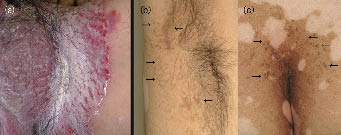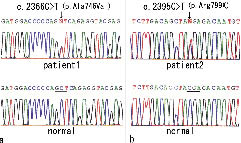Ikue Nemoto-Hasebe1, Masashi Akiyama1, Rinko Osawa2, Hiroyuki Nakamura2 and Hiroshi Shimizu1
Department of Dermatology, 1Hokkaido University Graduate School of Medicine, North 15 West 7, Kita-ku, Sapporo 060-8638, and 2Kushiro City General Hospital, Kushiro, Japan. E-mail: i-nemoto@med.hokudai.ac.jp
Accepted January 23, 2008.
Sir,
Hailey-Hailey disease (HHD; MIM 169600) and Darier disease (DD; MIM 124200) are rare autosomal dominant hereditary diseases caused by mutations in calcium pump genes. Specifically, patients with HHD have a defect in the gene ATP2C1 encoding the Golgi secretory pathway Ca2+-ATPase (hSPCA1) (1, 2), while DD is caused by a mutation in the gene ATP2A2 encoding the sarco/endoplasmic reticulum Ca2+-ATPase type 2 (SERCA2) (3). HHD is characterized by recurrent eruptions of vesicles and bullae, predominantly involving intertriginous areas, whereas in DD acantholytic, dyskeratotic papules are seen in seborrhoeic areas. Clinical features of HHD vary and include crusted erosions with vesicular pustules, and erythematous scaly plaques that resemble DD. We identified two heterozygous mutations, a novel mutation p. Ala746Val and a known mutation p. Arg799X, in two HHD patients from distinct families who showed quite different clinical features. One case showed the typical HHD phenotype and was easily diagnosed. However, the second case had atypical clinical features of keratotic papules without erosions and the diagnosis of HHD was made only after molecular genetic testing.
CASE REPORT
Case 1
A 58-year-old Japanese man showed typical clinical features of HHD with erythema and painful erosions in his axillae and groin (Fig. 1a, b). He had had these skin symptoms from his early twenties. Neither palms nor nails were involved. He had no apparent family history of any skin disorder. His skin symptoms were exacerbated by mechanical friction. Biopsy specimens from the groin revealed acantholysis and dyskeratosis in the suprabasal layers of the epidermis. From these findings, he was diagnosed with HHD and mutation analysis was performed in ATP2C1. Genomic DNA was extracted from his peripheral blood leukocytes using a standard procedure. Pairs of primers spanning all 28 exons of the ATP2C1 gene were used to amplify genomic DNA (2). PCR products were subject to direct sequencing by an ABI automated sequencer (PE Applied Biosystems, Foster City, CA, USA). C > T transition of nucleotide 2366 (c.C2366T) in exon 23 of ATP2C1 was detected. This novel mutation altered amino acid p.Ala746 to valine (p.Ala746Val) (Fig. 2a). This mutation was not detected in 50 unrelated, healthy Japanese individuals (100 normal alleles) and did not appear to be a polymorphism.
Fig. 1. Clinical features of the two patients. (a) Case 1: demarcated erythema with erosions in the left groin. (b) Case 2: pinkish or brownish keratotic papules were scattered in the right axilla (arrows) and (c) the intertriginous area of the buttocks. Note absence of erosion or ulcers.
Case 2
A 52-year-old Japanese man with a 5-month history of recurrent hyperkeratotic papules in his axillae, buttocks and inguinal regions, and erosions only on his popliteal fossae. There were no remarkable erosions in the inguinal regions (Fig. 1c). He had vitiligo vulgaris on the trunk and extremities. Neither nail change nor hyperkeratosis of the palm was seen. Various sized patches of vitiligo were scattered over his whole body. There was no family history of any skin symptoms and his 8 siblings and 2 sons were free of any skin disease. He had no apparent aggravating factor of skin symptoms. On histopathological examination of keratotic papules of his back, acantholysis within the suprabasal layers and scant numbers of corps ronds were observed in the epidermis.
In case 2, we initially suspected that the patient was suffering from DD. Thus, we performed mutation analysis in his ATP2A2 gene, the causative gene for DD; however, no mutation was detected. Subsequently, we searched for an ATP2C1 mutation using the methods described above, and identified a C > T transition at nucleotide 2395 (c.2395C > T) in exon 25 of ATP2C1, resulting in a nonsense mutation p. Arg799X and premature translation termination (Fig. 2b).
Fig. 2. Mutational analysis of ATP2C1. (a) Sequence chromatograms of ATP2C1 from case 1 showed the heterozygous transition c.2366C > T at codon 746 (p.Ala746Val), which was a novel mutation. (b) Sequence chromatograms of ATP2C1 from case 2 showed the heterozygous transition c.2395C > T at codon 799 resulting in a premature translation termination codon (p.Arg799X).
DISCUSSION
Case 1 presented with typical clinical features of HHD and was diagnosed clinically for HHD. Later, the diagnosis was confirmed by genetic testing. Case 2 showed generalized keratotic papules resembling DD and almost no erosions were seen in the intertriginous areas. Thus, we suspected a diagnosis of DD on clinical grounds. Genetic testing of ATP2A2 and subsequent ATP2C1 facilitated the precise diagnosis of HHD in this case.
In HHD, acantholysis is generally widespread and can be induced by external factors in clinically uninvolved skin (4), whereas dyskeratosis in seborrhoeic areas is a predominant feature of DD (5). The involvements of nails and palms, such as leukonychia longitudinalis and acrokeratosis verrucifomis, were reported as useful signs for the diagnosis of Hailey-Hailey disease (6, 7). Due to wide phenotypic variation in HHD, this disease shows considerable clinical and histological overlap with DD (8).
The majority of reported ATP2C1 mutations predict loss of function of the Golgi secretory pathway Ca2+-ATPase pump, suggesting a haplo-insufficient mechanism for the dominant inheritance pattern (1, 2). The precise mechanism leading to the HHD phenotype remains unclear. No apparent genotype-phenotype correlation was reported in ATP2C1 mutations and patients with HHD and rather environmental factors, patients’ lifestyle, excessive weight and occupation may significantly affect clinical presentation (9).
Case 2 showed atypical features of HHD. We found two reports of patients with HHD (10, 11) with the mutation p. Arg799X of ATP2C1 identical to the ATP2C1 mutation in case 2. However, no atypical clinical features were described in these cases. Thus, the atypical clinical features in case 2 were thought to be due mainly to non-genetic factors. In this context, HHD has a wide variety of phenotypes, and it is difficult to make a correct diagnosis of HHD in some cases, such as case 2. The two cases described here suggest that molecular genetic testing for ATP2C1 mutations is a powerful and reliable tool for the precise diagnosis of HHD.
REFERENCES
1. Hu Z, Bonifas JM, Beech J, Bench G, Shigihara T, Ogawa H, et al. Mutations in ATP2C1, encoding a calcium pump, cause Hailey-Hailey disease. Nat Genet 2000; 24: 61–65.
2. Sudbrak R, Brown J, Dobson-Stone C, Carter S, Ramser J, White J, et al. Hailey-Hailey disease is caused by mutations in ATP2C1 encoding a novel Ca(2+) pump. Human Mol Genet 2000; 9: 1131–1140.
3. Sakuntabhai A, Ruiz-Perez V, Carter S, Jacobsen N, Burge S, Monk S, et al. Mutations in ATP2A2, encoding a Ca2+ pump, cause Darier disease. Nat Genet 1999; 21: 271–277.
4. Burge SM, Millard PR, Wojnarowska F. Hailey-Hailey disease: a widespread abnormality of cell adhesion. Br J Dermatol 1991; 124: 329–332.
5. Steffen CG. Familial benign chronic pemphigus. Am J Dermatopathol 1987; 9: 58–73.
6. Yakis G, Csató M, Kemény L, Korom I, Morvay M, Dobozy A. Hailey-Hailey disease with acrokeratosis verruciformis Hopf. Acta Derm Venereol 1996 ;76:157.
7. Burge SM. Hailey-Hailey disease: the clinical features, response to treatment and prognosis. Br J Dermatol 1992; 126: 275-82.
8. Burge SM, Wilkinson JD. Darier-White disease: a review of the clinical features in 163 patients. J Am Acad Dermatol 1992; 27: 40–50.
9. Dobson-Stone C, Fairclough R, Dunne E, Brown J, Dissanayake M, Munro CS, et al. Hailey-Hailey disease: molecular and clinical characterization of novel mutations in the ATP2C1 gene. J Invest Dermatol 2002; 118: 338–343.
10. Chao SC, Tsai YM, Yang MH. Mutation analysis of ATP2C1 gene in Taiwanese patients with Hailey-Hailey disease. Br J Dermatol 2002; 146: 595–600.
11. Majore S, Biolcati G, Barboni L, Cannistraci C, Binni F, Crisi A, et al. ATP2C1 gene mutation analysis in Italian patients with Hailey-Hailey disease. J Invest Dermatol 2005; 125: 933–935.





